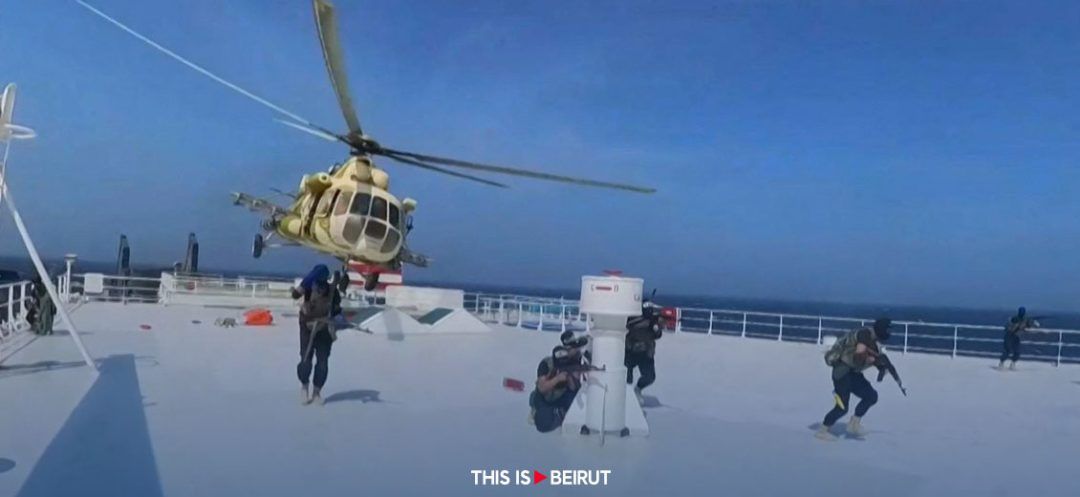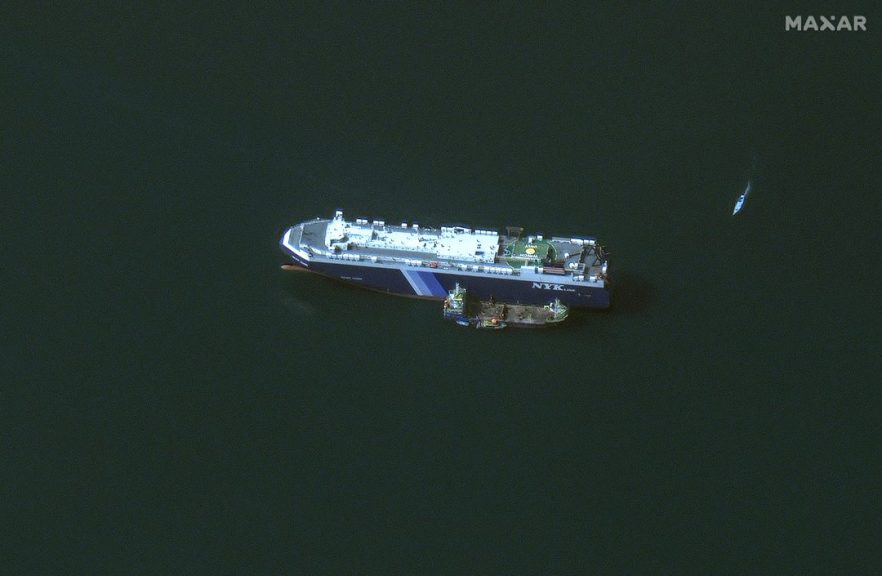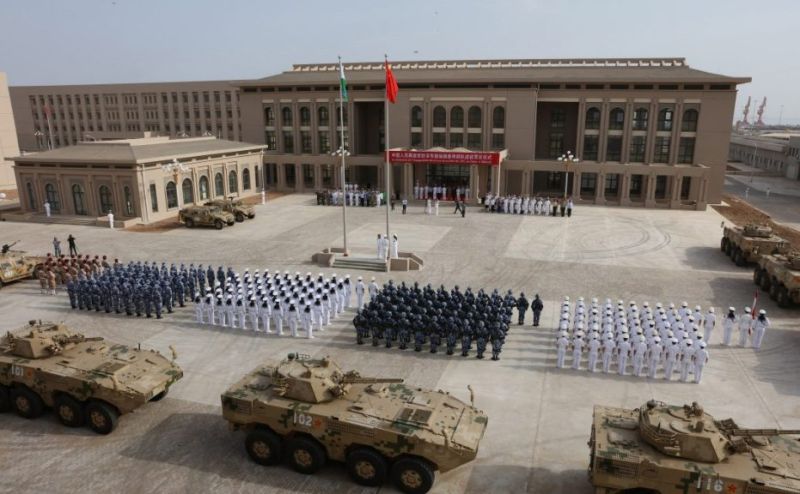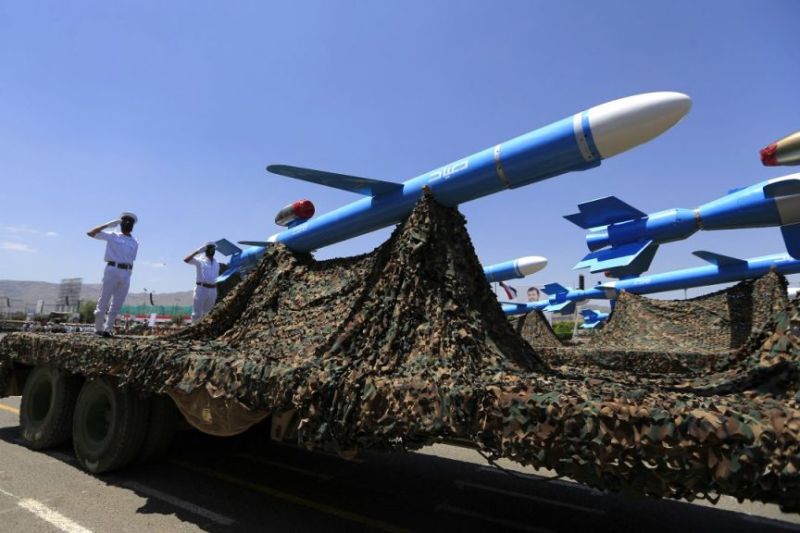- Home
- War in the Middle East
- Red Sea: Global Trade Hub

©(AFP)
The strikes carried out by the international coalition in the Red Sea since the beginning of the year once again illustrate the importance of this body of water for global maritime trade. Here are the key points to understand the specifics of this vital artery of major strategic importance.
Since October 7, 2023, the Red Sea has gradually become an extension of the conflict in Gaza. The Houthis, a Shiite Zaidi group that is supported by Iran and controls the west of Yemen, regularly carry out attacks on commercial ships in support of Hamas. As a result, major shipping companies have suspended the passage of their boats through this maritime area, significantly affecting global trade flows.
 The Galaxy Leader cargo ship, under Houthi control near Hodeida, Yemen, on November 28. (Maxar Technologies, AFP)
The Galaxy Leader cargo ship, under Houthi control near Hodeida, Yemen, on November 28. (Maxar Technologies, AFP)
The Red Sea, located between Northeast Africa and the Arabian Peninsula, occupies a crucial strategic position in the global network of maritime trade. These waters connect the Mediterranean and, more importantly, European economic spaces to the Indian Ocean and Asian economies via the Suez Canal to the north and the Bab el-Mandeb Strait (Gate of Tears) to the south. It provides a vital navigation route for goods and international trade. One of the world's most traveled maritime corridors, it is considered a “highway of the sea” connecting Europe to Asia.
Approximately 20,000 ships transit through the Suez Canal each year, carrying millions of barrels of oil and manufactured goods per day from Asia.
According to the London-based International Chamber of Shipping (ICS), 12% of global trade usually passes through the Red Sea. The Pentagon, on the other hand, mentions between 10 and 15%. Additionally, British newspaper The Guardian spoke of 30% of global container traffic in an article published in December 2023.
 Furthermore, the region hosts several major ports, including Port Said in Egypt, Djibouti and Jeddah in Saudi Arabia. A pipeline built by Saudi Arabia allows the country to transport oil extracted from fields located in the east of the country. These ports play a crucial role in facilitating trade between the Asian, African and European continents.
Furthermore, the region hosts several major ports, including Port Said in Egypt, Djibouti and Jeddah in Saudi Arabia. A pipeline built by Saudi Arabia allows the country to transport oil extracted from fields located in the east of the country. These ports play a crucial role in facilitating trade between the Asian, African and European continents.
Finally, oil shipments through the Red Sea represented about 12% of the total maritime oil transport in the first half of 2023. LNG shipments through these routes at that time constituted about 8% of global LNG trade, according to a note from S&P Global Commodity Insights.
Due to its economic importance, this region has become one of the most militarized in the world. Moreover, it accumulates points of tension, including the civil war in Sudan and piracy incidents in the Gulf of Aden off the coast of Somalia.
 This photo taken on August 1ᵉʳ, 2017 shows Chinese People's Liberation Army personnel attending the opening ceremony of the Chinese military base in Djibouti. (AFP)
This photo taken on August 1ᵉʳ, 2017 shows Chinese People's Liberation Army personnel attending the opening ceremony of the Chinese military base in Djibouti. (AFP)
Therefore, many countries deploy significant military assets in the region. The US Navy and its “Task Force 151,” as well as the navies of the European Union under Operation Atalanta, are among the most significant deployments. In addition, the navies of other countries such as the United Kingdom, Japan, China, Saudi Arabia and India are also present. The heart of this presence lies notably in Djibouti, where American, French and Japanese military bases coexist with facilities of the Chinese navy since 2017.
Nevertheless, the main challenge in the region remains the Houthis. Equipped with significant means, such as a plethora of drones and missiles supplied by their Iranian sponsors, they are capable of sustainably threatening global trade—a prospect that has partly become a reality: several global trade giants such as Maersk, MSC, CMA-CGM and Evergreen have announced the suspension of their passages in the Red Sea.
This has consequences for the ports in the region, such as Eilat in southern Israel, where activity has dropped by 85% since the beginning of Houthi attacks, according to its executive director. A similar situation is reported on the Egyptian side, where Suez Canal revenues are plummeting, as reported by The Guardian in December 2023.
 Houthi fighters on an anti-ship missile carrier during an official military parade, September 21, 2023. (Mohammed HUWAIS, AFP)
Houthi fighters on an anti-ship missile carrier during an official military parade, September 21, 2023. (Mohammed HUWAIS, AFP)
It is in this context that the United States launched, in December 2023, “Operation Prosperity Guardian,” which includes around 10 countries. However, this has not cooled the ardor of Tehran's local ally, which has even increased the frequency of its attacks.
As a result, US, British and forces from several other “Prosperity Guardian” participants began conducting strikes since early January 2024. A reaction that, for now, still does not seem to reassure major shipowners: they now prefer to bypass Africa rather than use the “Gate of Tears.”
Since October 7, 2023, the Red Sea has gradually become an extension of the conflict in Gaza. The Houthis, a Shiite Zaidi group that is supported by Iran and controls the west of Yemen, regularly carry out attacks on commercial ships in support of Hamas. As a result, major shipping companies have suspended the passage of their boats through this maritime area, significantly affecting global trade flows.
 The Galaxy Leader cargo ship, under Houthi control near Hodeida, Yemen, on November 28. (Maxar Technologies, AFP)
The Galaxy Leader cargo ship, under Houthi control near Hodeida, Yemen, on November 28. (Maxar Technologies, AFP)The Red Sea, located between Northeast Africa and the Arabian Peninsula, occupies a crucial strategic position in the global network of maritime trade. These waters connect the Mediterranean and, more importantly, European economic spaces to the Indian Ocean and Asian economies via the Suez Canal to the north and the Bab el-Mandeb Strait (Gate of Tears) to the south. It provides a vital navigation route for goods and international trade. One of the world's most traveled maritime corridors, it is considered a “highway of the sea” connecting Europe to Asia.
Global Trade Artery
Approximately 20,000 ships transit through the Suez Canal each year, carrying millions of barrels of oil and manufactured goods per day from Asia.
According to the London-based International Chamber of Shipping (ICS), 12% of global trade usually passes through the Red Sea. The Pentagon, on the other hand, mentions between 10 and 15%. Additionally, British newspaper The Guardian spoke of 30% of global container traffic in an article published in December 2023.
 Furthermore, the region hosts several major ports, including Port Said in Egypt, Djibouti and Jeddah in Saudi Arabia. A pipeline built by Saudi Arabia allows the country to transport oil extracted from fields located in the east of the country. These ports play a crucial role in facilitating trade between the Asian, African and European continents.
Furthermore, the region hosts several major ports, including Port Said in Egypt, Djibouti and Jeddah in Saudi Arabia. A pipeline built by Saudi Arabia allows the country to transport oil extracted from fields located in the east of the country. These ports play a crucial role in facilitating trade between the Asian, African and European continents.Finally, oil shipments through the Red Sea represented about 12% of the total maritime oil transport in the first half of 2023. LNG shipments through these routes at that time constituted about 8% of global LNG trade, according to a note from S&P Global Commodity Insights.
Major Geostrategic Zone
Due to its economic importance, this region has become one of the most militarized in the world. Moreover, it accumulates points of tension, including the civil war in Sudan and piracy incidents in the Gulf of Aden off the coast of Somalia.
 This photo taken on August 1ᵉʳ, 2017 shows Chinese People's Liberation Army personnel attending the opening ceremony of the Chinese military base in Djibouti. (AFP)
This photo taken on August 1ᵉʳ, 2017 shows Chinese People's Liberation Army personnel attending the opening ceremony of the Chinese military base in Djibouti. (AFP)Therefore, many countries deploy significant military assets in the region. The US Navy and its “Task Force 151,” as well as the navies of the European Union under Operation Atalanta, are among the most significant deployments. In addition, the navies of other countries such as the United Kingdom, Japan, China, Saudi Arabia and India are also present. The heart of this presence lies notably in Djibouti, where American, French and Japanese military bases coexist with facilities of the Chinese navy since 2017.
The Houthi Problem
Nevertheless, the main challenge in the region remains the Houthis. Equipped with significant means, such as a plethora of drones and missiles supplied by their Iranian sponsors, they are capable of sustainably threatening global trade—a prospect that has partly become a reality: several global trade giants such as Maersk, MSC, CMA-CGM and Evergreen have announced the suspension of their passages in the Red Sea.
This has consequences for the ports in the region, such as Eilat in southern Israel, where activity has dropped by 85% since the beginning of Houthi attacks, according to its executive director. A similar situation is reported on the Egyptian side, where Suez Canal revenues are plummeting, as reported by The Guardian in December 2023.
 Houthi fighters on an anti-ship missile carrier during an official military parade, September 21, 2023. (Mohammed HUWAIS, AFP)
Houthi fighters on an anti-ship missile carrier during an official military parade, September 21, 2023. (Mohammed HUWAIS, AFP)It is in this context that the United States launched, in December 2023, “Operation Prosperity Guardian,” which includes around 10 countries. However, this has not cooled the ardor of Tehran's local ally, which has even increased the frequency of its attacks.
As a result, US, British and forces from several other “Prosperity Guardian” participants began conducting strikes since early January 2024. A reaction that, for now, still does not seem to reassure major shipowners: they now prefer to bypass Africa rather than use the “Gate of Tears.”
Read more




Comments